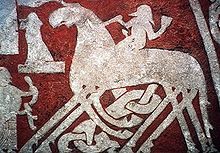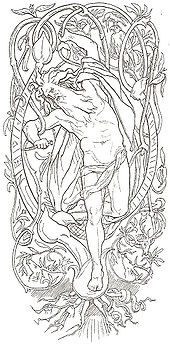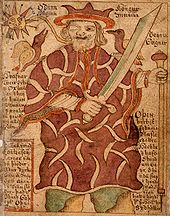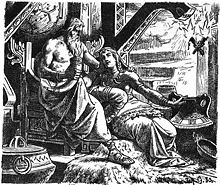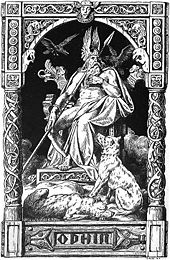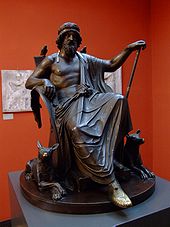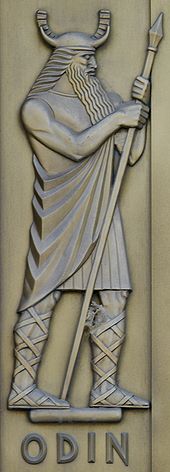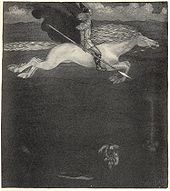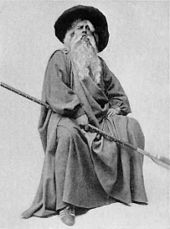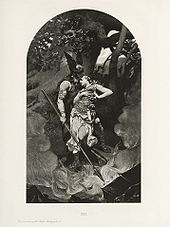- Odin
-
This article is about the chief god in North Germanic tradition. For other uses, see Odin (disambiguation). For a comparative discussion of North and West Germanic, see Wodanaz.
Odin 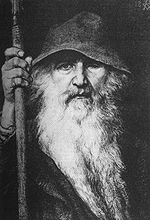
"Odin, the Wanderer" (1886) by Georg von RosenSky, War, Death, Magic, Wisdom Name in Old Norse Óðinn World Asgard Symbol Valknut Parents Borr and Bestla Siblings Vili and Vé Consort Frigg Children Sons of Odin Odin (pronounced /ˈoʊdɨn/ from Old Norse Óðinn) is a major god in Norse mythology and the ruler of Asgard.[1] Homologous with the Anglo-Saxon "Wōden" and the Old High German "Wotan", the name is descended from Proto-Germanic "*Wodanaz" or "*Wōđanaz". "Odin" is generally accepted as the modern English form of the name, although, in some cases, older forms may be used or preferred. In the compound Wednesday, the first member is cognate to the genitive Odin's. His name is related to ōðr, meaning "fury, excitation," besides "mind," or "poetry." His role, like that of many of the Norse gods, is complex. Odin is a principal member of the Æsir (the major group of the Norse pantheon) and is associated with war, battle, victory and death, but also wisdom, magic, poetry, prophecy, and the hunt. Odin has many sons, the most famous of whom is Thor.
Contents
Origins
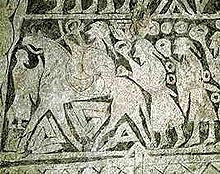 The 7th century Tängelgarda stone shows Odin leading a troop of warriors all bearing rings. Valknut symbols are drawn beneath his horse, which is depicted with four legs.
The 7th century Tängelgarda stone shows Odin leading a troop of warriors all bearing rings. Valknut symbols are drawn beneath his horse, which is depicted with four legs. Main article: Wodanaz
Main article: WodanazWorship of Odin may date to Proto-Germanic paganism. The Roman historian Tacitus may refer to Odin when he talks of Mercury. The reason is that, like Mercury, Odin was regarded as Psychopompos, "the leader of souls."
As Odin is closely connected with a horse called Sleipnir, a spear called Gungnir, and transformation/shape shifting into animal shapes, an alternative theory of origin contends that Odin, or at least some of his key characteristics, may have arisen just prior to the sixth century as a nightmarish horse god (Echwaz), later signified by the eight-legged Sleipnir. Some support for Odin as a latecomer to the Scandinavian Norse pantheon can be found in the Sagas where, for example, at one time he is thrown out of Asgard by the other gods — a seemingly unlikely tale for a well-established "all father." Scholars who have linked Odin with the "Death God" template include E. A. Ebbinghaus, Jan de Vries and Thor Templin. The later two also link Loki and Odin as being one-and-the-same until the early Norse Period[citation needed].
Scandinavian Óðinn emerged from Proto-Norse *Wōdin during the Migration period, artwork of this time (on gold bracteates) depicting the earliest scenes that can be aligned with the High Medieval Norse mythological texts. The context of the new elites emerging in this period aligns with Snorri's tale of the indigenous Vanir who were eventually replaced by the Æsir, intruders from the Continent.[2]
Parallels between Odin and Celtic Lugus have often been pointed out : both are intellectual gods, commanding magic and poetry. Both have ravens and a spear as their attributes. Julius Caesar (de bello Gallico, 6.17.1) mentions Mercury as the chief god of Celtic religion. A likely context of the diffusion of elements of Celtic ritual into Germanic culture is that of the Chatti, who lived at the Celtic-Germanic boundary in Hesse during the final centuries before the Common Era. (It should be remembered that many Indo-Europeanists hypothesize that Odin in his Proto-Germanic form was not the chief god, but that he only gradually replaced Týr during the Migration period.)
Adam of Bremen
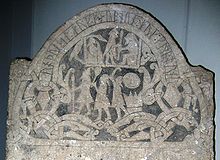 A detail from runestone G 181 in the Swedish Museum of National Antiquities in Stockholm. The three men are interpreted as Odin, Thor and Freyr.
A detail from runestone G 181 in the Swedish Museum of National Antiquities in Stockholm. The three men are interpreted as Odin, Thor and Freyr.
Written around 1080, one of the oldest written sources on pre-Christian Scandinavian religious practices is Adam of Bremen's Gesta Hammaburgensis ecclesiae pontificum. Adam claimed to have access to first-hand accounts on pagan practices in Sweden. His description of the Temple at Uppsala gives some details on the god.
In hoc templo, quod totum ex auro paratum est, statuas trium deorum veneratur populus, ita ut potentissimus eorum Thor in medio solium habeat triclinio; hinc et inde locum possident Wodan et Fricco. Quorum significationes eiusmodi sunt : 'Thor', inquiunt, 'praesidet in aere, qui tonitrus et fulmina, ventos ymbresque, serena et fruges gubernat. Alter Wodan, id est furor, bella gerit, hominique ministrat virtutem contra inimicos. Tertius est Fricco, pacem voluptatemque largiens mortalibus'. Cuius etiam simulacrum fingunt cum ingenti priapo.
-
- Gesta Hammaburgensis 26, Waitz' edition
In this temple, entirely decked out in gold, the people worship the statues of three gods in such wise that the mightiest of them, Thor, occupies a throne in the middle of the chamber; Wotan and Frikko have places on either side. The significance of these gods is as follows: Thor, they say, presides over the air, which governs the thunder and lightning, the winds and rains, fair weather and crops. The other, Wotan—that is, the Furious—carries on war and imparts to man strength against his enemies. The third is Frikko, who bestows peace and pleasure on mortals. His likeness, too, they fashion with an immense phallus.
-
- Gesta Hammaburgensis 26, Tschan's translation
Poetic Edda
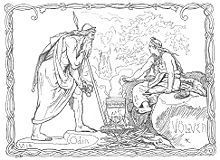 "Odin and the Völva" (1895) by Lorenz Frølich.
"Odin and the Völva" (1895) by Lorenz Frølich.
Völuspá
In the poem Völuspá, a völva tells Odin of numerous events reaching far into the past and future, including his own doom. The Völva describes creation, recounts the birth of Odin by his father Borr and his mother Bestla and how Odin and his brothers formed Midgard from the sea. She further describes the creation of the first human beings - Ask and Embla - by Hœnir, Lóðurr and Odin.
Amongst various other events, the Völva mentions Odin's involvement in the Æsir-Vanir War, the oedipism of Odin's eye at Mímir's Well, the death of his son Baldr. She describes how Odin is slain by the wolf Fenrir at Ragnarök, the subsequent avenging of Odin and death of Fenrir by his son Víðarr, how the world disappears into flames and, yet, how the earth again rises from the sea. She then relates how the surviving Æsir remember the deeds of Odin.
Lokasenna
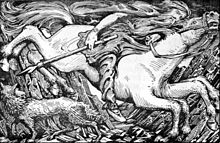 "Odin Rides to Hel" (1908) by W. G. Collingwood.
"Odin Rides to Hel" (1908) by W. G. Collingwood.
In the poem Lokasenna, the conversation of Odin and Loki started with Odin trying to defend Gefjun and ended with his wife, Frigg, defending him. In Lokasenna, Loki derides Odin for practicing seid (witchcraft), implying it was women's work. Another example of this may be found in the Ynglinga saga where Snorri opines that men who used seid were ergi or unmanly.
Hávamál
In Rúnatal, a section of the Hávamál, Odin is attributed with discovering the runes. In a sacrifice to himself, the highest of the gods, he was hung from the world tree Yggdrasil for nine days and nights, pierced by his own spear, in order to learn the wisdom that would give him power in the nine worlds. Nine is a significant number in Norse magical practice (there were, for example, nine realms of existence), thereby learning nine (later eighteen) magical songs and eighteen magical runes.
One of Odin's names is Ygg, and the Norse name for the World Ash —Yggdrasil—therefore could mean "Ygg's (Odin's) horse." Another of Odin's names is Hangatýr, the god of the hanged.
Hárbarðsljóð
Main article: HárbarðsljóðIn Hárbarðsljóð, Odin, disguised as the ferryman Hárbarðr, engages his son Thor, unaware of the disguise, in a long argument. Thor is attempting to get around a large lake and Hárbarðr refuses to ferry him.
Prose Edda
 A depiction of Odin riding Sleipnir from an eighteenth-century Icelandic manuscript.
A depiction of Odin riding Sleipnir from an eighteenth-century Icelandic manuscript.
Odin had three residences in Asgard. First was Gladsheim, a vast hall where he presided over the twelve Diar or Judges, whom he had appointed to regulate the affairs of Asgard. Second, Valaskjálf, built of solid silver, in which there was an elevated place, Hlidskjalf, from his throne on which he could perceive all that passed throughout the whole earth. Third was Valhalla (the hall of the fallen), where Odin received the souls of the warriors killed in battle, called the Einherjar. The souls of women warriors, and those strong and beautiful women whom Odin favored, became Valkyries, who gather the souls of warriors fallen in battle (the Einherjar), as these would be needed to fight for him in the battle of Ragnarök. They took the souls of the warriors to Valhalla. Valhalla has five hundred and forty gates, and a vast hall of gold, hung around with golden shields, and spears and coats of mail.
Odin has a number of magical artifacts associated with him: the spear Gungnir, which never misses its target; a magical gold ring (Draupnir), from which every ninth night eight new rings appear; and two ravens Huginn and Muninn (Thought and Memory), who fly around Earth daily and report the happenings of the world to Odin in Valhalla at night. He also owned Sleipnir, an octopedal horse, who was given to Odin by Loki, and the severed head of Mímir, which foretold the future. He also commands a pair of wolves named Geri and Freki, to whom he gives his food in Valhalla since he consumes nothing but mead or wine. From his throne, Hlidskjalf (located in Valaskjalf), Odin could see everything that occurred in the universe. The Valknut (slain warrior's knot) is a symbol associated with Odin. It consists of three interlaced triangles.
Odin is an ambivalent deity. Old Norse (Viking Age) connotations of Odin lie with "poetry, inspiration" as well as with "fury, madness and the wanderer." Odin sacrificed his eye (which eye he sacrificed is unclear) at Mímir's spring in order to gain the Wisdom of Ages. Odin gives to worthy poets the mead of inspiration, made by the dwarfs, from the vessel Óð-rœrir.[3]
Odin is associated with the concept of the Wild Hunt, a noisy, bellowing movement across the sky, leading a host of slain warriors.
Consistent with this, Snorri Sturluson's Prose Edda depicts Odin as welcoming the great, dead warriors who have died in battle into his hall, Valhalla, which, when literally interpreted, signifies the hall of the slain. The fallen, the einherjar, are assembled and entertained by Odin in order that they in return might fight for, and support, the gods in the final battle of the end of Earth, Ragnarök. Snorri also wrote that Freyja receives half of the fallen in her hall Folkvang.
He is also a god of war, appearing throughout Norse myth as the bringer of victory.[citation needed] In the Norse sagas, Odin sometimes acts as the instigator of wars, and is said to have been able to start wars by simply throwing down his spear Gungnir, and/or sending his valkyries, to influence the battle toward the end that he desires. The Valkyries are Odin's beautiful battle maidens that went out to the fields of war to select and collect the worthy men who died in battle to come and sit at Odin's table in Valhalla, feasting and battling until they had to fight in the final battle, Ragnarök. Odin would also appear on the battle-field, sitting upon his eight-legged horse Sleipnir, with his two ravens, one on each shoulder, Hugin (Thought) and Munin (Memory), and two wolves (Geri and Freki) on each side of him.
Odin is also associated with trickery, cunning, and deception. Most sagas have tales of Odin using his cunning to overcome adversaries and achieve his goals, such as swindling the blood of Kvasir from the dwarves.
On September 2, 2009 an amateur archaeologist found a small silver figurine at Lejre in Denmark. It has been dated to around AD 900. The figurine is only 2 centimeters tall and shows a person sitting on a throne adorned with two beast heads and flanked by two birds on the arm-rests. The excavator interpreted the piece as a representation of Odin, Hugin and Munin.[4] Scholars specialising in Viking Period dress and gender representations, however, pointed out that the person is dressed entirely in female attire, making it more probably a goddess such as Freya or Frigga.
Prologue
Snorri Sturluson feels compelled to give a rational account of the Æsir in the prologue of his Prose Edda. In this scenario, Snorri speculates that Odin and his peers were originally refugees from the Anatolian city of Troy, folk etymologizing Æsir as derived from the word Asia. In any case, Snorri's writing (particularly in Heimskringla) tries to maintain an essentially scholastic neutrality. That Snorri was correct was one of the last of Thor Heyerdahl's archeoanthropological theories, forming the basis for his Jakten på Odin.
Gylfaginning
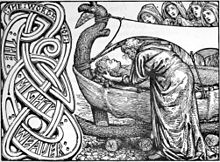 "Odin's last words to Baldr" (1908) by W.G. Collingwood.
"Odin's last words to Baldr" (1908) by W.G. Collingwood.
According to the Prose Edda, Odin, the first and most powerful of the Æsir, was a son of Bestla and Borr and brother of Vili and Vé. With these brothers, he cast down the frost giant Ymir and made Earth from Ymir's body. The three brothers are often mentioned together. "Vili" is the German word for "will" (English), "Vé" is the German word (Gothic wai) for woe but is more likely related to the archaic German "Wei" meaning 'sacred.'
Odin has fathered numerous children. With his wife, Frigg, he fathered his doomed son Baldr and the blind god Höðr. By the personification of earth, Fjörgyn or Jörð, Odin was the father of his most famous son, Thor. By the giantess Gríðr, Odin was the father of Vídar, and by Rinda he was father of Váli. Also, many royal families claimed descent from Odin through other sons. For traditions about Odin's offspring, see Sons of Odin.
Odin and his brothers, Vili and Ve, are attributed with slaying Ymir, the Ancient Giant, to form Midgard. From Ymir's flesh, the brothers made the earth, and from his shattered bones and teeth they made the rocks and stones. From Ymir's blood, they made the rivers and lakes. Ymir's skull was made into the sky, secured at four points by four dwarfs named East, West, North, and South. From Ymir's brains, the three Gods shaped the clouds, whereas Ymir's eyebrows became a barrier between Jotunheim (giant's home) and Midgard, the place where men now dwell. Odin and his brothers are also attributed with making humans.
After having made earth from Ymir's flesh, the three brothers came across two logs (or an ash and an elm tree). Odin gave them breath and life; Vili gave them brains and feelings; and Ve gave them hearing and sight. The first man was Ask and the first woman was Embla.
Odin was said to have learned the mysteries of seid from the Vanic goddess and völva Freyja, despite the unwarriorly connotations of using magic.
Skáldskaparmál
In section 2 of Skáldskaparmál, Odin's quest for wisdom can also be seen in his work as a farmhand for a summer, for Baugi, and his seduction of Gunnlod in order to obtain the Mead of Poetry.
In section 5 of Skáldskaparmál, the origins of some of Odin's possessions are described.
Sagas of Icelanders
Ynglinga saga
According to the Ynglinga saga:
Odin had two brothers, the one called Ve, the other Vili, and they governed the kingdom when he was absent. It happened once when Odin had gone to a great distance, and had been so long away that the people Of Asia doubted if he would ever return home, that his two brothers took it upon themselves to divide his estate; but both of them took his wife Frigg to themselves. Odin soon after returned home, and took his wife back.
In Ynglinga saga, Odin is considered the 2nd Mythological king of Sweden, succeeding Gylfi and was succeeded by Njörðr.
Further, in Ynglinga saga, Odin is described as venturing to Mímir's Well, near Jötunheimr, the land of the giants; not as Odin, but as Vegtam the Wanderer, clothed in a dark blue cloak and carrying a traveler's staff. To drink from the Well of Wisdom, Odin had to sacrifice his eye (which eye he sacrificed is unclear), symbolizing his willingness to gain the knowledge of the past, present and future. As he drank, he saw all the sorrows and troubles that would fall upon men and the gods. He also saw why the sorrow and troubles had to come to men.
Mímir accepted Odin's eye and it sits today at the bottom of the Well of Wisdom as a sign that the father of the gods had paid the price for wisdom.
Other sagas
According to Njáls saga: Hjalti Skeggiason, an Icelander newly converted to Christianity, wished to express his contempt for the native gods, so he sang:
- "Ever will I Gods blaspheme
- Freyja methinks a dog does seem,
- Freyja a dog? Aye! Let them be
- Both dogs together Odin and she!"[5]
Hjalti was found guilty of blasphemy for his infamous verse and he ran to Norway with his father-in-law, Gizur the White. Later, with Olaf Tryggvason's support, Gizur and Hjalti came back to Iceland to invite those assembled at the Althing to convert to Christianity (which happened in 999).[6][7]
The Saga of King Olaf Tryggvason, composed around 1300, describes that following King Olaf Tryggvason's orders, to prove their piety, people must insult and ridicule major heathen deities when they are newly converted into Christianity. Hallfreðr vandræðaskáld, who was reluctantly converted from paganism to Christianity by Olaf, also had to make a poem to forsake pagan deities. Below is an example:
- The whole race of men to win
- Odin's grace has wrought poems
- (I recall the exquisite
- works of my forebears);
- but with sorrow, for well did
- Viðrir's [Odin's] power please the poet,
- do I conceive hate for the first husband of
- Frigg [Odin], now I serve Christ. (Lausavísur 10, Whaley's translation)
Flateyjarbók
Sörla þáttr is a short narrative from a later and extended version of the Saga of Olaf Tryggvason[8] found in the Flateyjarbók manuscript, which was written and compiled by two Christian priests, Jon Thordson and Magnus Thorhalson, from the late 14th[9] to the 15th century.[10]
"Freyja was a human in Asia and was the favorite concubine of Odin, King of Asialand. When this woman wanted to buy a golden necklace (no name given) forged by four dwarves (named Dvalinn, Alfrik, Berling, and Grer), she offered them gold and silver but they replied that they would only sell it to her if she would lie a night by each of them. She came home afterward with the necklace and kept silent as if nothing happened. But a man called Loki somehow knew it, and came to tell Odin. King Odin commanded Loki to steal the necklace, so Loki turned into a fly to sneak into Freyja's bower and stole it. When Freyja found her necklace missing, she came to ask king Odin. In exchange for it, Odin ordered her to make two kings, each served by twenty kings, fight forever unless some christened men so brave would dare to enter the battle and slay them. She said yes, and got that necklace back. Under the spell, king Högni and king Heðinn battled for one hundred and forty-three years, as soon as they fell down they had to stand up again and fight on. But in the end, the great Christian lord Olaf Tryggvason arrived with his brave christened men, and whoever slain by a Christian would stay dead. Thus the pagan curse was finally dissolved by the arrival of Christianity. After that, the noble man, king Olaf, went back to his realm."[11]
Gesta Danorum
In the 13th century, Saxo Grammaticus, in the service of Archbishop Absalon in Denmark, presented in his Latin language work Gesta Danorum euhemerized accounts of Thor and Odin as cunning sorcerers that, Saxo states, had fooled the people of Norway, Sweden and Denmark into their recognition as gods:
"There were of old certain men versed in sorcery, Thor, namely, and Odin, and many others, who were cunning in contriving marvellous sleights; and they, winning the minds of the simple, began to claim the rank of gods. For, in particular, they ensnared Norway, Sweden and Denmark in the vainest credulity, and by prompting these lands to worship them, infected them with their imposture. The effects of their deceit spread so far, that all other men adored a sort of divine power in them, and, thinking them either gods or in league with gods, offered up solemn prayers to these inventors of sorceries, and gave to blasphemous error the honour due to religion. Some say that the gods, whom our countrymen worshipped, shared only the title with those honoured by Greece or Latium, but that, being in a manner nearly equal to them in dignity, they borrowed from them the worship as well as the name. This must be sufficient discourse upon the deities of Danish antiquity. I have expounded this briefly for the general profit, that my readers may know clearly to what worship in its heathen superstition our country has bowed the knee." (Gesta Danorum, Book I)[12]
Saxo also wrote a story about how Odin's wife, Frigg, slept with a servant to obtain a device to steal Odin's gold.
"At this time there was one Odin, who was credited over all Europe with the honour, which was false, of godhead, but used more continually to sojourn at Upsala; and in this spot, either from the sloth of the inhabitants or from its own pleasantness, he vouchsafed to dwell with somewhat especial constancy.
The kings of the North, desiring more zealously to worship his deity, embounded his likeness in a golden image; and this statue, which betokened their homage, they transmitted with much show of worship to Byzantium, fettering even the effigied arms with a serried mass of bracelets. Odin was overjoyed at such notoriety, and greeted warmly the devotion of the senders. But his queen Frigg, desiring to go forth more beautified, called smiths, and had the gold stripped from the statue.
Odin hanged them, and mounted the statue upon a pedestal, which by the marvellous skill of his art he made to speak when a mortal touched it. But still Frigg preferred the splendour of her own apparel to the divine honours of her husband, and submitted herself to the embraces of one of her servants; and it was by this man's device she broke down the image, and turned to the service of her private wantonness that gold which had been devoted to public idolatry. Little thought she of practicing unchastity, that she might the easier satisfy her greed, this woman so unworthy to be the consort of a god; but what should I here add, save that such a godhead was worthy of such a wife? So great was the error that of old befooled the minds of men.
Thus Odin, wounded by the double trespass of his wife, resented the outrage to his image as keenly as that to his bed; and, ruffled by these two stinging dishonours, took to an exile overflowing with noble shame, imagining so to wipe off the slur of his ignominy. At home, Frigg went with a certain Mith-Othin and took over Odin's properties, until Odin came back and drove them away. Frigg's death later cleared Odin's name and he regained his reputation." (Gesta Danorum, Book I)[12]
There is also an account about how Odin was exiled by the Latin gods at Byzantium:
But the gods, whose chief seat was then at Byzantium, (Asgard), seeing that Odin had tarnished the fair name of godhead by divers injuries to its majesty, thought that he ought to be removed from their society. And they had him not only ousted from the headship, but outlawed and stripped of all worship and honour at home...[13]
Blót
Main article: BlótIt is attested in primary sources that sacrifices were made to Odin during blóts. Adam of Bremen relates that every ninth year, people assembled from all over Sweden to sacrifice at the Temple at Uppsala. Male slaves and males of each species were sacrificed and hung from the branches of the trees.
As the Swedes had the right not only to elect their king but also to depose him, the sagas relate that both King Domalde and King Olof Trätälja were sacrificed to Odin after years of famine. It has been argued that the killing of a combatant in battle was to give a sacrificial offering to Odin. The fickleness of Odin in war was well documented; in Lokasenna, Loki taunts Odin for his inconsistency.
Sometimes sacrifices were made to Odin to bring about changes in circumstance. A notable example is the sacrifice of King Víkar that is detailed in Gautrek's Saga and in Saxo Grammaticus' account of the same event. Sailors in a fleet being blown off course drew lots to sacrifice to Odin that he might abate the winds. The king himself drew the lot and was hanged.
Sacrifices were probably also made to Odin at the beginning of summer (mid April, actually—summer being reckoned essentially the same as did the Celt, at Beltene, Calan Mai [Welsh], which is Mayday—hence as summer's "herald"), since Ynglinga saga states one of the great festivals of the calendar is at sumri, þat var sigrblót "in summer, for victory;" Odin is consistently referred to throughout the Norse mythos as the bringer of victory. The Ynglinga saga also details the sacrifices made by the Swedish king Aun, to whom it was revealed that he would lengthen his life by sacrificing one of his sons every ten years; nine of his ten sons died this way. When he was about to sacrifice his last son Egil, the Swedes stopped him.
Persisting beliefs and folklore
The Christianization of Scandinavia was slow, and it worked its way downwards from the nobility. Among commoners, beliefs in Odin lingered and legends would be told until modern times.
The last battle where Scandinavians attributed a victory to Odin was the Battle of Lena in 1208.[14] The former Swedish king Sverker had arrived with a large Danish army, and the Swedes led by their new king Eric were outnumbered. It is said that Odin then appeared riding on Sleipnir and he positioned himself in front of the Swedish battle formation. He led the Swedish charge and gave them victory.
The Bagler sagas, written in the thirteenth century concerning events in the first two decades of the thirteenth century, tells a story of a one-eyed rider with a broad-brimmed hat and a blue coat who asks a smith to shoe his horse. The suspicious smith asks where the stranger stayed during the previous night. The stranger mentions places so distant that the smith does not believe him. The stranger says that he has stayed for a long time in the north and taken part in many battles, but now he is going to Sweden. When the horse is shod, the rider mounts his horse and says "I am Odin" to the stunned smith, and rides away. The next day, the battle of Lena took place. The context of this tale in the saga is that a peace-treaty has been signed in Norway, and Odin, a god of war, no longer has a place there.
Hákonar saga Hákonarsonar, written in the 1260s, describes how, at some point in the 1230s, Skule Baardsson has the skald Snorri Sturluson compose a poem comparing one of Skule's enemies to Odin, describing them both as bringers of strife and disagreement. These episodes do not necessarily imply a continued belief in Odin as a god, but show clearly that his name was still widely known at this time.
Scandinavian folklore also maintained a belief in Odin as the leader of the Wild Hunt. His main objective seems to have been to track down and kill a lady who could be the forest dweller huldran or skogsrået. In these accounts, Odin was typically a lone hunter, save for his two dogs.[15]
In late 19th century Danish folklore, an account of Odin as having hid in a cliff of Møen (modern Møn, Denmark) where his residence there is "still pointed out." At this time, he was referred to as the "Jætte (giant) from Uppsala" but "is now called Jön Upsal" and from this latter name comes the expression "Men jötten dog!" as opposed to the expression "Men Jös dog!" ("By Jesus!"). Outside his doorway a green spot is described on the otherwise white cliff; this is where he "goes out on behalf of nature". A man who "now lives in Copenhagen" is described as having once sailed along the cliff, having seen Jön toss out his "dirt" - a big cloud of dust was to be seen outside of his door. Several "still living people" have lost their way in Klinteskoven ("The Cliff Forest") and ended up in Jön Upsal's garden, that is said to be so big and wonderful that it is beyond any description. The garden is also in full bloom in midwinter. If one sets out to find this garden, it is impossible to find.[16]
Santa Claus
Santa Claus, a jolly old fat man with a long white beard who is said to distribute presents to well-behaved children on Christmas Eve, is largely based on Odin, merged with the Christian legend of Saint Nicholas of Myra.[17] Most Christmas traditions in Germanic countries derive from celebrations of the pagan winter solstice holiday Yule as a result of the gradual merging of the two holidays.
Odin was recorded as leading a great Yule hunting party through the sky.[18] Two books from Iceland, the Poetic Edda, compiled in the 13th century from earlier sources, and the Prose Edda, written in the 13th century by Snorri Sturluson, describe Odin as riding an eight-legged horse named Sleipnir that could leap great distances, giving rise to comparisons to Santa Claus's reindeer.[19] Further, Odin was referred to by many names in Skaldic poetry, some of which describe his appearance or functions; these include Síðgrani,[20] Síðskeggr,[21] Langbarðr,[22] (all meaning "long beard") and Jólnir[23] ("Yule figure").
According to Phyllis Siefker, children would place their boots, filled with carrots, straw, or sugar, near the chimney for Odin's flying horse, Sleipnir, to eat. Odin would then reward those children for their kindness by replacing Sleipnir's food with gifts or candy. This practice, she claims, survived in Germany, Belgium, and the Netherlands after the adoption of Christianity and became associated with Saint Nicholas as a result of the process of Christianization and can be still seen in the modern practice of the hanging of stockings at the chimney in some homes.[24]
Names
Main article: List of names of OdinOdin was referred to by more than 200 names which hint at his various roles. Among others, he was known as Yggr (terror), Sigfodr (father of Victory) and Alfodr (All Father)[25] in the skaldic and Eddic traditions of heiti and kennings, a poetic method of indirect reference, as in a riddle.
Some epithets establish Odin as a father god: Alföðr "all-father," "father of all;" Aldaföðr "father of men (or of the age);" Herjaföðr "father of hosts;" Sigföðr "father of victory;" Valföðr "father of the slain."
Eponymy
Main article: List of places named after OdinMany toponyms in Northern Europe where Germanic Tribes existed contain the name of *Wodanaz (Norse Odin, West Germanic Woden).
Wednesday is named after Woden, the English form of Odin (Old English Wēdnes dæg, "Woden's day"). It is an early Germanic translation of the Latin dies Mercurii ("Mercury's day")[citation needed].
Odin came to be used as a Norwegian male given name from the 19th century, originally in the context of the Romanticist Viking revival[citation needed].
Modern influence
Art and literature
In a letter of 1946 J.R.R. Tolkien stated that he thought of Gandalf as an "Odinic wanderer."[26] Other commentators have also compared Gandalf to Odin in his "Wanderer" guise – an old man with one eye, a long white beard, a wide brimmed hat, and a staff.[27] In addition, Odin appears in the 1939 novel The Ship That Flew by Hilda Lewis. Odin is also the main God character in the 2001 novel American Gods by Neil Gaiman; the character of Odin is primarily called Wednesday and the All-Father in the novel. The 2011 TV series The Almighty Johnsons features Norse gods in modern New Zealand, the main character being Axl Johnson, who discovers on his 21st birthday he is the incarnation of Odin.
Germanic neopaganism
Odin, along with the other Germanic Gods and Goddesses, is recognized by Germanic neopagans. His Norse form is particularly acknowledged in Ásatrú, the "faith in the Æsir", an officially recognized religion in Iceland, Denmark, Norway, Sweden and Spain.[28]
See also
- List of Germanic deities
- Odin from Lejre
- Mitra
- Svarog
- The Odin Brotherhood
References
- ^ New York Times
- ^ Rundkvist, Martin (April 2003). Post festum. Solid gold in the Vendel Period.. http://www.algonet.se/~arador/postfestum.html. Retrieved 2008-07-06.
- ^ Skaldskaparmal, in Edda. Anthony Faulkes, Trans., Ed. (London: Everyman, 1996).
- ^ Jyllands-Posten, "Sensationelt fund af Odin-figur", November 14 2009 (in Danish).
- ^ Njál's Saga or The Story of Burnt Njal, George W. DaSent transl. (1861).
- ^ Craigie, William Alexanger (1914). The Religion Of Ancient Scandinavia. http://books.google.com/?id=sYZEZ9GiWqYC&printsec=frontcover&dq=Religion+Of+Ancient+Scandinavia#v=onepage&q=.
- ^ T. Kendrick, "History of the Vikings" (1930), p.349, 350.
- ^ The Younger Edda. Rasmus B. Anderson transl. (1897) Chicago: Scott, Foresman & Co. (1901).
- ^ Lindow, John. Norse Mythology: A Guide to the Gods, Heroes, Rituals, and Beliefs, pages 280–281. (2001) Oxford: Oxford University Press. ISBN 0-19-515382-0.
- ^ Rasmus B. Anderson, Introduction to The Flatey Book. Norræna Society, London (1908).
- ^ This short story is also known as "The Saga of Högni and Hedinn". English translation can be found at Northvegr: Three Northern Love Stories and Other Tales.
- ^ a b Elton, Oliver (1905). The Nine Books of the Danish History of Saxo Grammaticus. New York: Norroena Society. http://omacl.org/DanishHistory/book1.html.
- ^ Elton, Oliver (1905). The Nine Books of the Danish History of Saxo Grammaticus (Book III). New York: Norroena Society. http://omacl.org/DanishHistory/book3.html.
- ^ Starbäck, Carl Georg, & Bäckström, Per Olof. Berättelser ur Svenska Historien. Stockholm: F. & G. Beijers Förlag (1885–86), Vol. 1, p. 325
- ^ Schön, Ebbe. (2004). Asa-Tors hammare, Gudar och jättar i tro och tradition. Fält & Hässler, Värnamo. ISBN 91-89660-41-2 pp. 201–205.
- ^ Kristensen, Evald Tang. (1980) Danske Sagn: Som De Har Lyd I Folkemunde, page 103. Nyt Nordisk Forlag Arnold Busck, Copenhagen. ISBN 87-17-02791-8
- ^ McKnight, George Harley. St. Nicholas - His Legend and His Role in the Christmas Celebration (1917) Available on-line: [1]
- ^ The Encyclopedia Americana (1920) (page 307) Available online: [2].
- ^ Collier's Encyclopedia (1986) (Page 414)
- ^ Found in Alvíssmál (6)
- ^ Found in Gylfaginning, Grímnismál (48), Nafnaþulur, Óðins nöfn (6)
- ^ Found in Nafnaþulur and Óðins nöfn (7)
- ^ Found in Óðins nöfn (7)
- ^ Siefker, Phyllis (2006). Santa Claus, Last of the Wild Men: The Origins and Evolution of Saint Nicholas, Spanning 50,000 Years. McFarland & Co.. pp. 171–173 and chap. 9. ISBN 0786429585. http://books.google.com/?id=xSrjsgvCu8YC&printsec=frontcover&q.
- ^ Harrison, D. & Svensson, K. (2007). Vikingaliv Fälth & Hässler, Värnamo. ISBN 978-91-27-35725-9 p. 63
- ^ Letters, no. 107.
- ^ Burns, Marjorie (2005). Perilous Realms: Celtic and Norse in Tolkien's Middle-earth. University of Toronto Press. pp. 97. ISBN 0-8020-3806-9. http://books.google.com/?id=ZGzMwxyoi5wC&printsec=frontcover&dq=Perilous+Realms:+Celtic+and+Norse+in+Tolkien%27s+Middle-earth#v=onepage&q=.
- ^ Confesiones Minoritarias - MINISTERIO DE JUSTICIA
Further reading
- A. Asbjorn Jon's "Shamanism and the Image of the Teutonic Deity, Óðinn"
- Kevin J. Wanner, "God on the Margins: Dislocation and Transience in the Myths of Óðinn," History of Religions, 46,4 (2007), 316–350.
- Patton, Kimberley Christine (2009). "Myself to Myself: The Norse Odin and Divine Autosacrifice". Religion of the Gods: Ritual, Paradox, and Reflexivity. Oxford University Press. ISBN 978-0-19-509106-9. http://books.google.com/?id=8vmJcw1WBtQC&printsec=frontcover&q.
Attributes Wild Hunt · Valhalla · Einherjar · Huginn and Muninn · Sleipnir · Geri and Freki · Hlidskjalf · GungnirOther Norse paganism Deities,
heroes,
and figuresOthersAsk and Embla · Dís (Norns · Valkyries) · Dwarf · Einherjar · Elves (Light elves · Dark elves) · Fenrir · Hel · Jörmungandr · Jötunn · Sigurd · Völundr · Vættir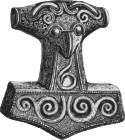
Locations Asgard · Bifröst · Fólkvangr · Ginnungagap · Hel · Jötunheimr · Midgard · Múspellsheimr · Niflheim · Valhalla · Vígríðr · Wells (Mímisbrunnr · Hvergelmir · Urðarbrunnr) · YggdrasilEvents Sources Society See also Preceded by
GylfiMythological king of Sweden Succeeded by
NjörðrCategories:- Woden
- Inventors of writing systems
- Mythological kings of Sweden
- Monomyths
- War gods
- Wisdom gods
- Hunting gods
- Sky and weather gods
- Oracular gods
- Magic gods
- Völsung cycle
- Æsir
-
Wikimedia Foundation. 2010.

